 Most viewed Most viewed |
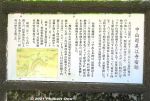
About Mieji-juku in Japanese.1 views
|
|
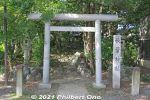
Akiba Shrine is also here. 秋葉神社1 views
|
|
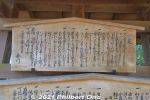
Replica of Mieji-juku's Kosatsu official bulletin board. 高札1 views
|
|
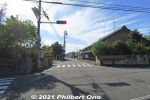
Turn the corner here.1 views
|
|
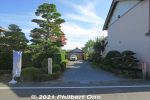
Site of Mieji-juku's Honjin (VIP lodging). The building no longer exists. This was Mieji-juku's highest elevation at only 10 meters. 本陣跡1 views
|
|
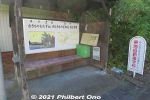
Looks like a rest place for travelers. Not a bus stop.1 views
|
|
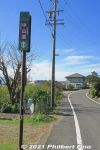
Walk further to see the small Kannon-do Hall.1 views
|
|
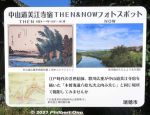
Next to Kanzeon-do Hall is Saikawa River depicted in Hiroshige's woodblock print. 犀川1 views
|
|

Hiroshige's woodblock print for Mieji-juku showing Saikawa River and two farmers giving directions to a priest. It was a low-lying area near three rivers and prone to flooding. 犀川1 views
|
|
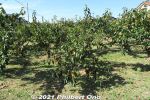
Mizuho is a major producer of Fuyu-gaki persimmons. 1 views
|
|
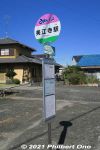
Bust stop at Mieji Station. Buses very infrequent.1 views
|
|
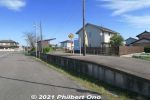
Back to Mieji Station.1 views
|
|

Onomichi Castle overlooking Onomichi Station. It was built in 1964 solely as a local museum and tourist attraction. 1 views
|
|
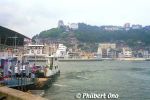
On Mukaishima island, the ferry to Onomichi. Onomichi Castle can be seen across the water.1 views
|
|

Danish street.1 views
|
|

Stone lantern in Kunigawa Onsen. "Onsen" means hot spring.1 views
|
|
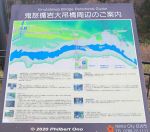
Near most major hot spring hotels is Tateiwa Promenade, a walking path along Kinugawa River. Something to do during the day. 楯岩遊歩道1 views
|
|
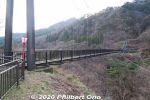
Kinutateiwa Bridge is for pedestrians only. Spans 140 meters long, and 37 meters above the river. 鬼怒楯岩大吊橋1 views
|
|
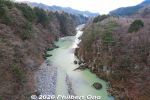
Kinugawa River as seen from Kinutateiwa Bridge.1 views
|
|
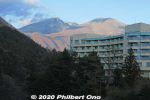
Kinugawa Onsen1 views
|
|
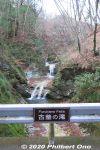
After crossing the bridge, go left and you will soon see Furukama Falls. 古釜の滝1 views
|
|

Tateiwa Kinuhime Shrine. Pray here to find a good mate, have a child, long life, and business prosperity. 楯岩鬼怒姫神社1 views
|
|
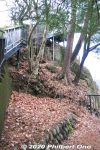
1 views
|
|
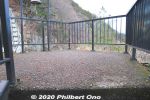
Tateiwa Scenic Point is a small lookout deck on a small hill 104 meters above the river. 楯岩展望台1 views
|
|
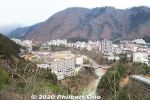
From Tateiwa Scenic Point, fine views of Kinugawa Onsen spa. 楯岩展望台1 views
|
|
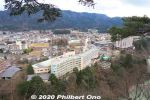
From Tateiwa Scenic Point, fine views of Kinugawa Onsen spa. 楯岩展望台1 views
|
|
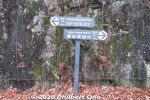
Directions back.1 views
|
|
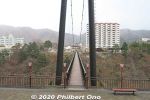
Kinutateiwa Bridge over Kinugawa River.1 views
|
|
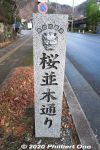
Cherry blossom road in Kinugawa Onsen.1 views
|
|
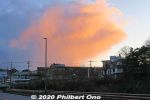
Sunset clouds in Kinugawa Onsen.1 views
|
|
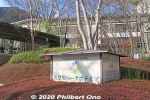
Kinugawa Park Hotels, where we stayed overnight in Kinugawa Onsen hot spring. Very nice hotel. 鬼怒川パークホテルズ1 views
|
|
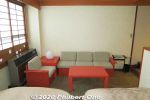
Sofa1 views
|
|

1 views
|
|
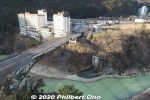
1 views
|
|
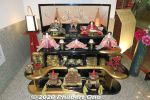
Hina dolls at Kinugawa Park Hotels.1 views
|
|
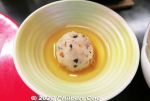
1 views
|
|
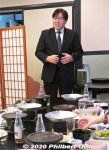
The hotel president also greeted us during dinner and gave us the VIP treatment.1 views
|
|
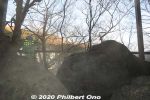
View from the outdoor bath.1 views
|
|
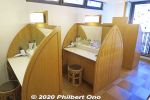
Hair dryers, etc.1 views
|
|
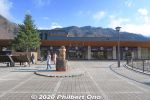
Kinugawa Onsen Station.1 views
|
|
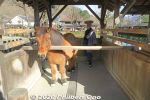
Small horse (live). Pay ¥200 to get carrots to feed the horse.1 views
|
|
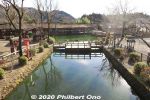
View from Ryogoku Bridge.1 views
|
|
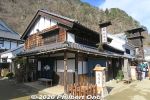
Echigoya gift shop.1 views
|
|
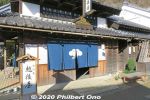
Echigoya gift shop.1 views
|
|
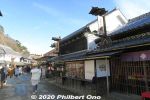
Soba noodle restaurant.1 views
|
|
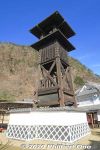
Fire tower1 views
|
|
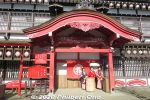
Wakamatsu-ya Theater is the park's most eye-catching building. 若松屋1 views
|
|
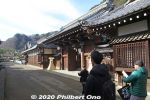
Samurai District, local magistrate's residence. 南町奉行所1 views
|
|
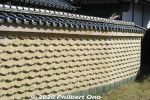
Roof tiles in a wall.1 views
|
|
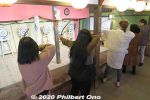
Yaba Archery Dojo1 views
|
|
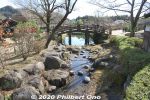
1 views
|
|

About the ninja mansion. Pregnant women should not enter.1 views
|
|
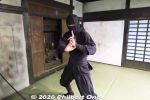
Ninja guide1 views
|
|
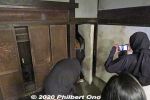
Revolving wall.1 views
|
|
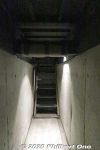
Under floor secret path.1 views
|
|
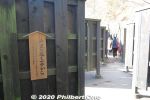
Ninja Maze1 views
|
|
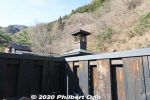
Tower in the middle of the maze is a reference point.1 views
|
|
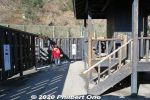
1 views
|
|
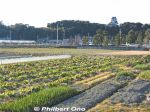
Koyama Castle was built by the Takeda Clan in 1568, but destroyed by Tokugawa Ieyasu in 1582 and never rebuilt. Yoshida Town Historic Site.1 views
|
|
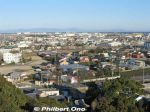
View from Koyama Castle.1 views
|
|
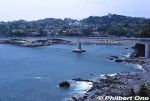
The bridge going to Manazuru Peninsula is on Route 135.1 views
|
|

Cape Manazuru tip with Mitsu-ishi (三ツ石) or Rock Trio. Two of the pointy rocks are bound by a shimenawa sacred rope. It's a noted spot for watching the New Year's first sunrise which rises between the two roped rocks.1 views
|
|

Mitsu-ishi (三ツ石) rocks bound by a shimenawa sacred rope.1 views
|
|
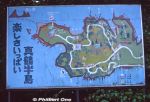
Old map of Manazuru Peninsula.1 views
|
|
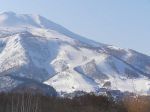
For many years, even before Niseko became popular among overseas skiers, Niseko was long known in Japan as offering the best powder snow. There are multiple ski resorts in Niseko and I skiied on three of them. This is Niseko Hirafu. ニセコ ヒラフ1 views
|
|

Niseko Hirafu has both easy and steep (moguls) slopes. ニセコ ヒラフ1 views
|
|

Niseko Hirafu ski lift. ニセコ ヒラフ1 views
|
|

Niseko Annupuri ski grounds has a different view of Mt. Yotei compared to Hirafu. ニセコアンヌプリ1 views
|
|
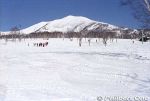
Niseko Annupuri 1 views
|
|
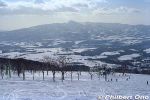
Views while skiing on Niseko Annupuri. ニセコアンヌプリ1 views
|
|

Views from Niseko Annupuri at close to sunset.1 views
|
|

Views from Niseko Annupuri. ニセコアンヌプリ1 views
|
|

Niseko Moiwa ski run. We skiied here at night. ニセコモイワ1 views
|
|

Bihoro Pass is within Akan-Mashu National Park. 1 views
|
|

1 views
|
|

1 views
|
|

1 views
|
|
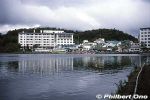
On the southern shore is Akanko Onsen hot spring with hotels and inns. Boat cruises also operate. These photos were taken years ago, so a few buildings might look different today. 阿寒湖温泉1 views
|
|
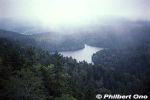
Only part of Lake Penketo can be seen from the road. Part of the Akan Volcanic Complex. ペンケトー1 views
|
|

Shintoku Ski Grounds as seen from the train in autumn. The building is the ski lodge where you buy lift tickets, etc.1 viewsNear JR Shintoku Station (JR Nemuro Line).
|
|
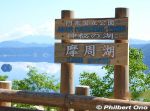
Newer Lake Mashu sign at a lookout point. 1 views
|
|

View of Lake Mashu from Scenic Point 1.1 views
|
|
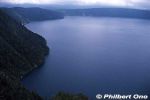
1 views
|
|

Beautiful shades of blue.1 views
|
|
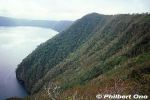
1 views
|
|

Mt. Io, meaning "Sulphur Mountain," is a lava dome spewing steam and sulphur gases. Tourists can walk and easily see the sulphur and steam vents. 1 views
|
|
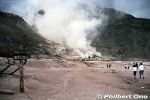
Literally nicknamed "Sulfur Mountain," Mt. Io is a convenient, steaming tourist attraction between Lake Kussharo and Lake Mashu. The mountain's Ainu name is "Atosa-nupuri," meaning "naked mountain" since it hardly has an1 views
|
|

Since there was no machinery in those days, mining operations were done manually with a pick and shovel. Prison labor was used for the mining. The sulphur was then loaded on horseback and boats to Kushiro.1 views
|
|

1 views
|
|
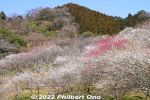
Takao Baigo is in the area of the famous Mt. Takao. It's an area with several plum blossom groves mainly along a road called Kyu-Koshu Kaido (旧甲州街道) near JR Takao Station and Keio Line Takaosanguchi Station. 1 views
|
|
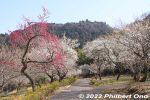
Takao Baigo was established in 1964 by a local tourist group. They happened to have multiple plum groves in this area, so they decided to market them together as a tourist attraction named "Takao Baigo" (Takao Plum Blossom Area).1 views
|
|
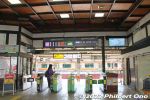
JR Takao Station. Takes a little over an hour from Tokyo Station on the JR Chuo Line.1 views
|
|
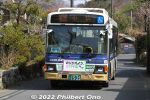
Buses run only once an hour on weekdays and two or three times per hour on weekends. Take the bus going to Kobotoke (小仏).1 views
|
|

When I took the bus from Takao Station in mid-morning, it was packed even on a weekday during peak bloom.1 views
|
|
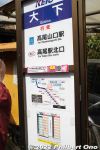
If you want to see the largest plum grove first (Kogesawa Bairin), get off here at the Oshimo stop (大下). Takes about 20-30 min. from Takao Station.1 views
|
|
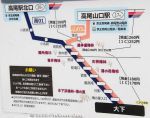
Bus stops between the two nearest train stations and Takao Baigo.1 views
|
|
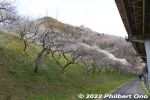
Walking up to the top of Kogesawa Bairin along this path on the periphery.1 views
|
|
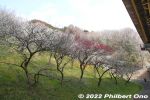
Kogesawa Bairin is on a hillside.1 views
|
|
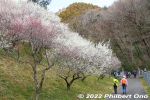
1 views
|
|
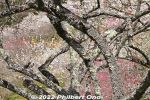
Plum trees also have lichens growing on the trunk and branches. These lichens form on plum trees in rural areas. We don't see them on plum trees in the city because exhaust fumes from vehicles kill them. 1 viewsSo if you see these lichens on plum trees, it means the surrounding environment is very clean. (Parmotrema tinctorum ウメノキゴケ)
|
|
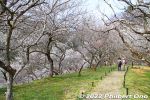
1 views
|
|
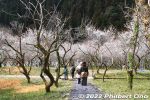
Steps going down hill of plum trees at Kogesawa Bairin.1 views
|
|
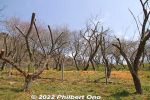
Some plum trees with pruned branches. May they flower again someday.1 views
|
|
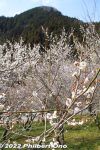
The grove is near the mountains, so there's a nice backdrop.1 views
|
|
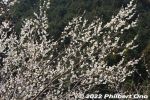
1 views
|
|
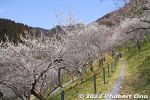
1 views
|
|
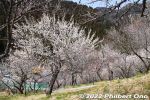
1 views
|
|
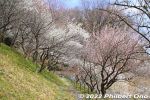
1 views
|
|
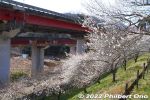
1 views
|
|
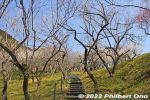
1 views
|
|
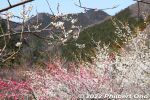
1 views
|
|
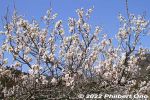
1 views
|
|
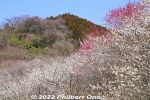
Kogesawa Bairin plum grove at Takao Baigo, Hachioji, Tokyo.1 views
|
|
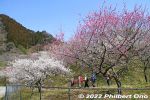
1 views
|
|
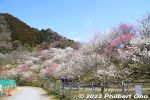
1 views
|
|
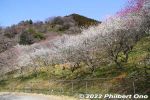
1 views
|
|
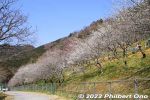
1 views
|
|
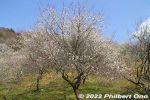
1 views
|
|
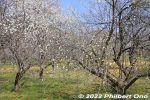
1 views
|
|
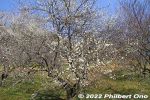
1 views
|
|
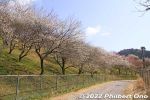
1 views
|
|
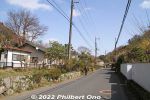
It's a quiet, rural, residential area along a small river. As you keep walking, you see plum trees here and there.1 views
|
|
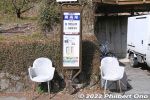
Bus stop1 views
|
|
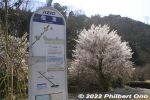
1 views
|
|
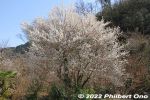
1 views
|
|
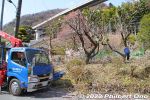
Pruning plum trees.1 views
|
|
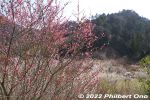
1 views
|
|
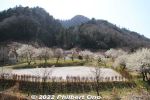
The next plum grove was Surusashi Bairin (するさし梅林). This might be the second largest plum grove in Takao Baigo.1 views
|
|
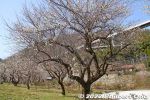
1 views
|
|
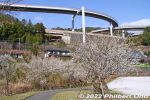
1 views
|
|
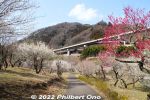
Surusashi Bairin has just one main path in the middle. The Chuo Expressway (goes to Nagoya via Nagano) is in the background.1 views
|
|
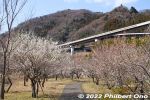
Surusashi Bairin1 views
|
|
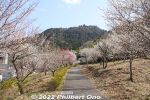
Surusashi Bairin1 views
|
|
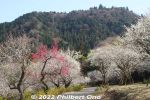
Other end of Surusashi Bairin.1 views
|
|
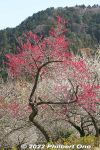
Since they are so few in Takao, the red plums really stand out.1 views
|
|
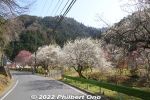
The public cannot enter Yunohana Bairin, so you just see it from the road.1 views
|
|
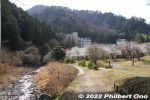
A grove named Takao Ume-no-Sato Machi-no-Hiroba. 1 views
|
|
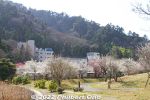
Takao Ume-no-Sato Machi-no-Hiroba is more for picnicking.1 views
|
|
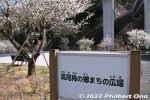
Takao Ume-no-Sato Machi-no-Hiroba1 views
|
|
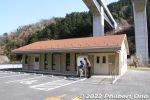
Takao Ume-no-Sato Machi-no-Hiroba has restrooms.1 views
|
|
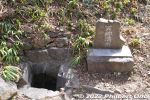
Tenjin Bairin well.1 views
|
|
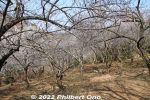
1 views
|
|

About Takao Tenmangu Shrine. Plum blossoms are associated with Sugawara Michizane because he once wrote a poem for his beloved plum blossoms that "flew through the air" to follow him when he was exiled to Dazaifu, Fukuoka.1 views
|
|
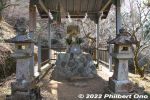
People in this Takao area have been worshipping Tenjin for centuries. Most all Tenmangu/Tenjin shrines (thousands of them) have plum blossoms.1 views
|
|
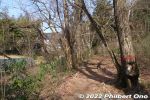
Walking path along the river.1 views
|
|
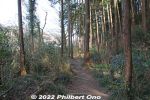
1 views
|
|
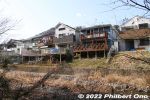
Homes along the river.1 views
|
|
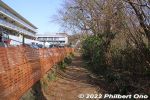
1 views
|
|
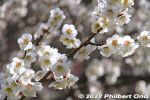
1 views
|
|
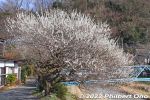
Yuhodo Bairin (遊歩道梅林)1 views
|
|
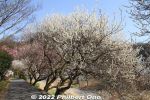
1 views
|
|
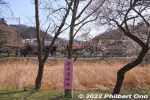
1 views
|
|
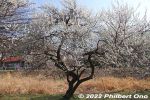
1 views
|
|
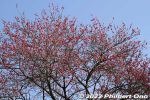
1 views
|
|
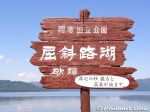
Lake Kussharo has two tourist areas. One is here at Sunayu. 砂湯1 views
|
|
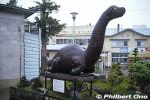
Lake Kussharo was also known for the "Kusshi" legend similar to the Loch Ness Monster, "Nessie." Credible sightings of Kussi were widely reported from 1973-1974, but stopped after the 2000s.1 viewsThis is an old statue displayed at JR Bihoro Station. Newer statue is at Sunayu near the lake shore.
|
|

Boats can be rented at Sunayu. In May 1938, the Kussharo Earthquake had sulfates seep into the lake from the lake bottom, making the water too acidic (pH4) for fish which got wiped out. 1 views
|
|

By the 2000s, the water acidity decreased enough to introduce fish which could endure the acidity. Only small stocks of rainbow trout, Kokanee, and Masu salmon are now in the lake. The lake has no fishing industry.1 views
|
|
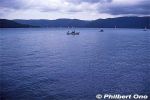
1 views
|
|

1 views
|
|

Wakoto Peninsula's west side.1 views
|
|

Wakoto Peninsula1 views
|
|
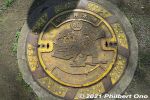
Water hose manhole for firemen.1 views
|
|
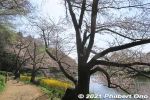
Some cherry blossoms along Junsai-ike Pond in late March. じゅん菜池1 views
|
|
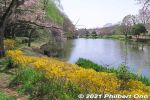
In autumn, Junsai-ike Pond is also noted for fall leaves.1 views
|
|
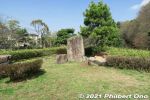
Small island in the middle of the pond.1 views
|
|
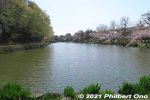
Junsai-ike Pond. No swan boats or rowboats. Only ducks. じゅん菜池1 views
|
|
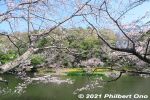
Cherry blossoms along Junsai-ike Pond. じゅん菜池1 views
|
|
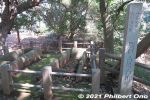
Two stone coffins on Akedo Kofun burial mound. Experts believe that they contained the remains of local nobility who ruled this area in the 6th to 7th century. Chiba Prefecture has many of these stone coffins. 明戸古墳石棺1 views
|
|
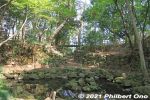
Konodai Castle remains in Satomi Park. Embankments and rocks. 国府台城1 views
|
|
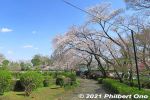
Satomi Park cherry blossoms.1 views
|
|
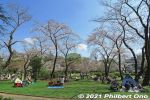
This is where most people enjoyed Satomi Park, under the cherry blossoms.1 views
|
|

About Shien-soja. It was originally located in Koiwa (Edogawa Ward, Tokyo) and moved here. (紫烟草舎).1 views
|
|
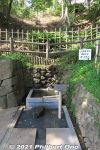
Old well on the fringe of Satomi Park named "Rakan-no-I". 羅漢の井1 views
|
|
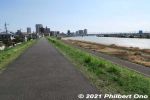
Straight ahead is the bridge for the Keisei Line. 江戸川沿い1 views
|
|
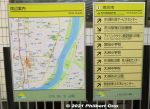
Directions at Ichikawa Station.1 views
|
|

Looking west toward Edogawa River. The JR Sobu Line (left) and Keisei Line (extreme right) over Edogawa River can be seen. The bridge in the middle is Route 14.1 views
|
|

Looking further upstream on Edogawa River. Left of the river is Edogawa (Koiwa) and Katsushika (Shibamata) Wards.1 views
|
|
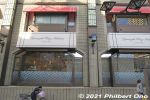
Yamazaki Plaza Ichikawa, a coffee shop and bakery operated by Yamazaki Baking in front of Ichikawa Station. This was a good place for refreshments before heading home.1 views
|
|
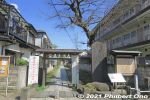
Near Guhoji is Tekona Reijindo, another temple. We didn't go to see this temple though. (Too tired walking.) Tekona Reijindo is dedicated to a local girl named Tekona who lived 2,000 years ago. 手児奈霊神堂1 viewsHer job was to fetch water from a well. She was such a beautiful girl that every man who saw her fell in love with her and wanted to marry her. They even fought over her. Even the moon fell in love with her. She got so distraught by all the attention and fighting that she drowned herself in the well. Poor girl, she was loved to death.
|
|
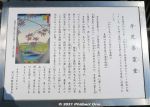
In 1501, Tekona's spirit told a priest to build a grave for her. This evolved into this temple where women pray for maternal happiness including safe childbirth and child rearing. 手児奈霊神堂1 views
|
|
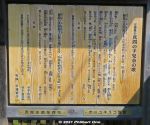
Poem about Tekona.1 views
|
|
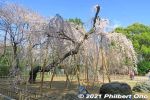
The weeping cherry tree looks different from different angles.1 views
|
|
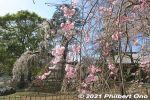
1 views
|
|
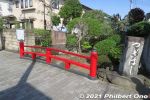
Mama no Tsughihashi Bridge near the steps going up to Guhoji Temple. The bridge is mentioned in some poems in the Man'yoshu. 真間の継橋1 views
|
|
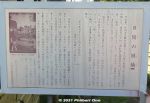
About Mama no Tsughihashi Bridge. 真間の継橋1 views
|
|

Mama River empties into Edogawa River. We later walked along Edogawa River toward Konodai Station on the Keisei Line.1 views
|
|
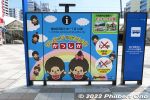
There's a boy and girl Monchicchi usually depicted as infants sucking their thumbs.1 views
|
|
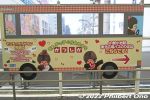
1 views
|
|
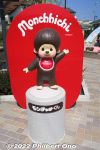
Boy Monchicchi-kun greets you.1 views
|
|
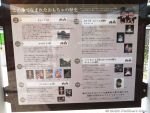
History of Sekiguchi Corporation, inventor of Monchicchi.1 views
|
|
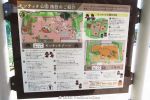
Monchicchi Park layout. Upper left is the new Monchicchi Zone and lower right is the new Chibikko Hiroba for infants.1 views
|
|

1 views
|
|
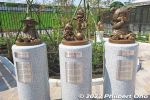
On the left is Mademoiselle Jeje from 1973. Her thumb-sucking was also incorporated in Monchicchi. In the middle are clown dolls for music boxes in 1984.1 views
|
|
|
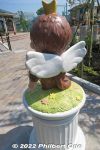
Monchicchi angel has its own corner of the park. 天使のモンチッチ1 views
|
|
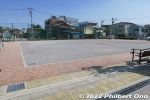
Main part of Monchicchi Park. Good place to run around, play with radio-controlled cars, or use playground equipment. This is also the emergency evacuation zone.1 views
|
|
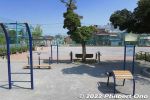
In this corner, fitness equipment for stretching your body.1 views
|
|
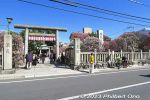
The shrine was historically famous for plum trees where even Hiroshige created a woodblock print. However, in 1910, a great flood ruined the garden. The current garden was built in 1994. Free admission. 1 views
|
|
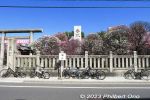
The plum blossoms bursting at the seams at this small shrine called Omurai Katori Shrine in Sumida Ward, Tokyo1 views
|
|
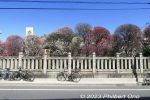
1 views
|
|
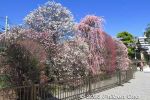
Plum trees on left side of the shrine.1 views
|
|
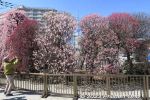
1 views
|
|
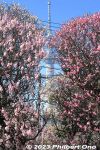
View of Tokyo Sky Tree through the plum blossoms.1 views
|
|
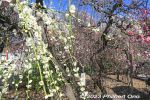
1 views
|
|
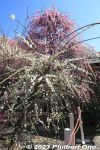
1 views
|
|
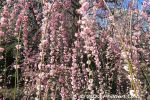
Pink weeping plum blossoms.1 views
|
|
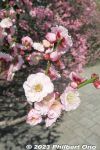
1 views
|
|
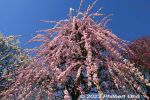
Pink weeping plum blossoms.1 views
|
|
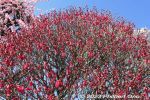
Red plum blossoms.1 views
|
|
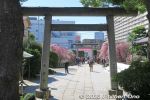
View from Omurai Katori Shrine's main worship hall.1 views
|
|

1 views
|
|
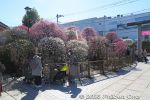
Plum blossoms on the right side of the shrine.1 views
|
|
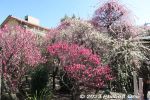
1 views
|
|
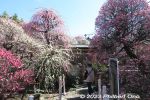
Entrance to the plum garden on the right side of the shrine. 1 views
|
|
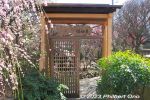
Entrance to the small plum blossom garden named Kobaien. 香梅園1 views
|
|
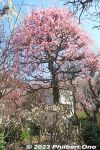
Large weeping plum tree in Kobaien garden.1 views
|
|
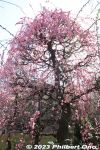
1 views
|
|
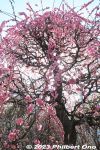
1 views
|
|
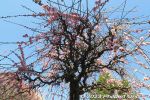
1 views
|
|
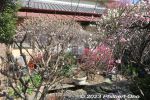
1 views
|
|
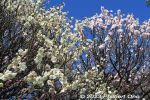
1 views
|
|
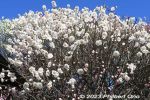
1 views
|
|
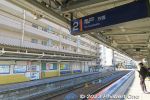
Omurai Station on the Tobu Kameido Line. 1 views
|
|
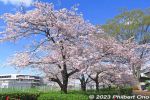
1 views
|
|
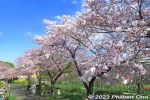
These were still one or two days before peak bloom.1 views
|
|
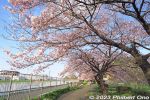
1 views
|
|
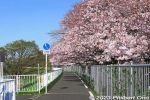
A long cycling path goes along Shin-Shibakawa River and the America cherry blossoms.1 views
|
|
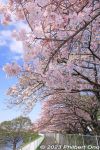
1 views
|
|
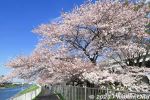
1 views
|
|
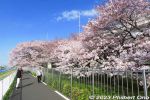
1 views
|
|
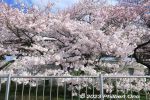
1 views
|
|
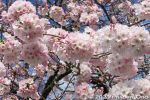
1 views
|
|
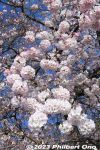
1 views
|
|
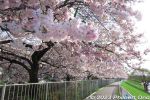
1 views
|
|
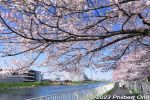
1 views
|
|
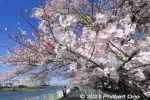
1 views
|
|
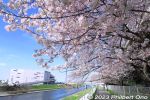
1 views
|
|
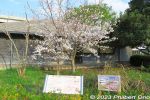
The park also has this Reagan Sakura cherry tree planted here in April 2012 to mark the centennial of Tokyo gifting cherry trees from Adachi Ward to the US in 1912.1 viewsThis tree came from the original "Reagan Sakura" cherry tree planted in Nov. 1982 from a sapling given to Japan by Nancy Reagan in 1981. The sapling came from the original cherry tree planted in Washington, DC's Tidal Basin by Mrs. Helen Taft, the wife of President Willian Taft, in 1912.
|
|

About Adachi Ward's Japan-US Cherry Blossom connection and centennial in 2012.1 views
|
|
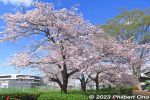
"America" Somei-Yoshino cherry trees from America at the park when in bloom. They are planted for a few hundred meters along Shin-Shibakawa River behind the Visitors Center. This was in late March.1 views
|
|
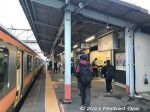
JR Musashi-Masuko Station1 views
|
|
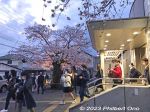
Yasube'e cherry blossoms have been welcoming local residents returning home by train for almost 100 years at JR Musashi-Masuko Station.1 views
|
|
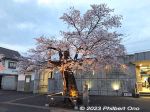
This sakura tree bloomed for the last time in March 2023 when these pictures were taken. 1 views
|
|
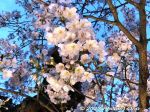
Closeup of cherry blossoms in front of JR Musashi-Masuko Station.1 views
|
|
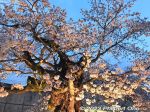
Sorry to see you go...1 views
|
|
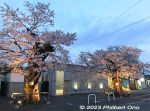
In front of Musashi-Masuko Station are these two Yasube'e cherry blossom trees. The third one is further toward the right.1 views
|
|
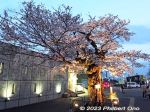
1 views
|
|
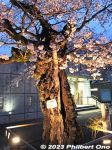
1 views
|
|
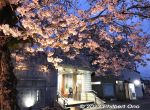
We'll miss you much.1 views
|
|
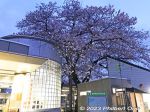
The third cherry tree at JR Musashi-Masuko Station.1 views
|
|
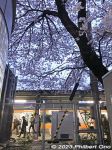
The third cherry tree at JR Musashi-Masuko Station is right next to the train platform. Too close.1 views
|
|
| 71191 files on 283 page(s) |
 |
 |
 |
 |
282 |
|